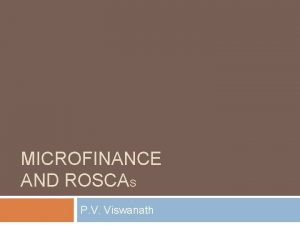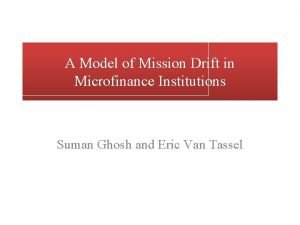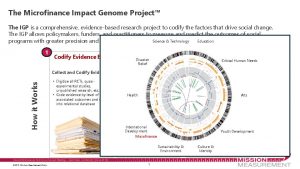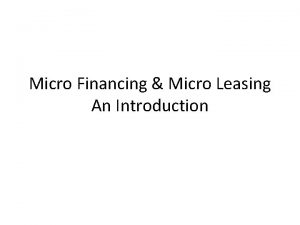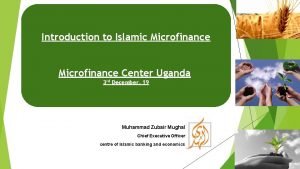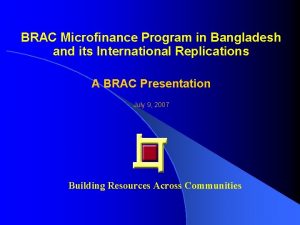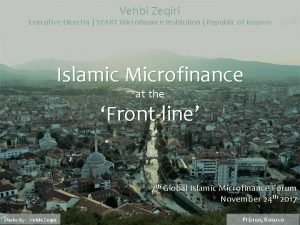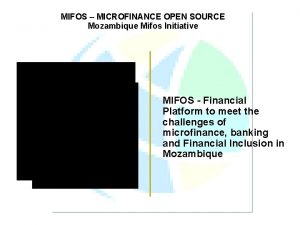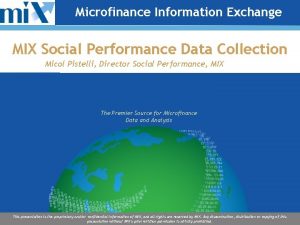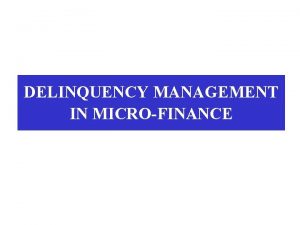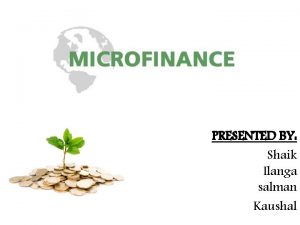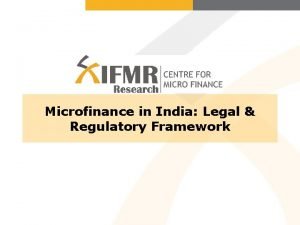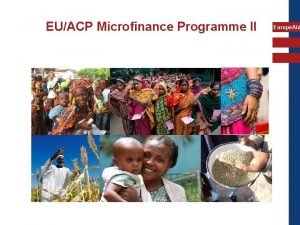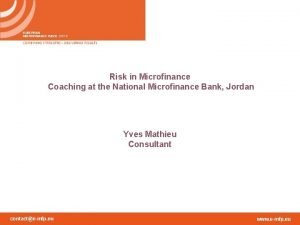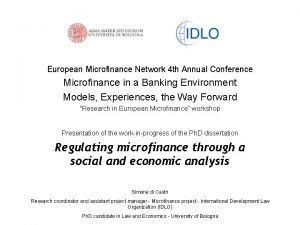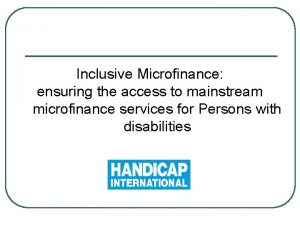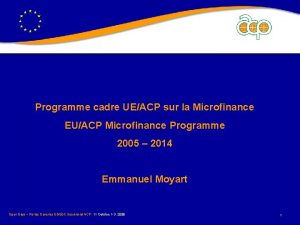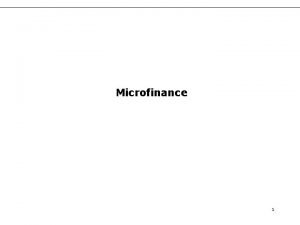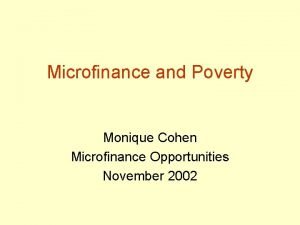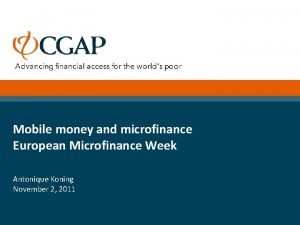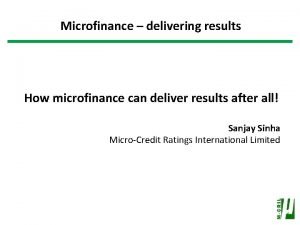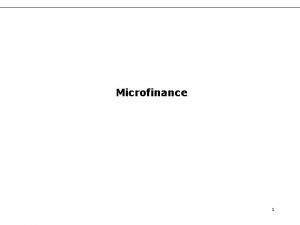A Model of Mission Drift in Microfinance Institutions














- Slides: 14

A Model of Mission Drift in Microfinance Institutions Suman Ghosh and Eric Van Tassel

Motivation • Growing trend towards commercialization in microfinance. For example, ACCION. • Several well publicized debates. 1. Yunus and Omidyar. The New Yorker (2006) 2. Controversy around the 2007 IPO held by Banco Compartamos of Mexico. NYT (April 2008) 3. Overview in Cull et al (2009, JEP)

Reactions Attracting private sector funds will free MF from “the ghetto of highminded, donor-supported initiatives”. MF can now compete alongside commercial banks for billions of dollars in the global capital markets. M. Yunus condemned the IPO; Compartamos is nothing but a brute moneylender, the very beast that Grameen Bank was built to root out. Now its about how the investors & MFI are doing and not about ending poverty. When you take a dollar of profit from a poor person this is money that could be used to reduce poverty.

Our approach We develop a model in which MFIs use fixed budgets to issue loans in order to minimize poverty. Ø Related work: Mc. Intosh and Wydick (2005), & Jain and Mansuri (2004). We include poverty minimizing donors and donors trying to maximize profit by lending to the poor. From Cull et al. (2007) we define mission drift: “. . microbanks moved away from servicing their poorer clients in pursuit of commercial viability ”.

Main findings Due to the entry of profit oriented donors: 1. The most efficient MFI adjusts its portfolio to include a higher fraction of less poor borrowers. 2. The MFI portfolio earns a higher financial return. 3. The amount of poverty reduction per dollar invested in the MFI falls. 4. The total amount of poverty falls.

The model Population of agents. Each agent has a risky project that generates a gross return if successful & zero if unsuccessful. Probability of success is where. • Poorest agents have wealth and need loan. • Less poor agents have and need loan size Assume < & <

MFI has a budget. MFI issues fraction of its loans to agents with a high probability of success. Each loan issued absorbs a transaction cost c > 0. Note: the interest rate on loans is exogenous. Choice variable: Number of small and large loans Choose to minimize Corner solution. Result. Depending on , MFI either specializes in lending to the very poor or the less poor.

Two measures of MFI performance Poverty return • The expected reduction in poverty expressed as a fraction of the MFI’s budget • MFI will maximize poverty return for a fixed budget Portfolio return • The expected profit of the MFI’s lending portfolio expressed as a fraction of the MFI’s budget Lemma 1. For a given portfolio, the higher the MFI’s portfolio return the greater the impact on poverty.

Poverty Donors Fully informed donors and MFI share the same objective function: This scenario depicts the early decades of microfinance when donors were often directly involved in creating and running MFI. Proposition 3. Each MFI specializes according to loan size.

Profit Donor Now we have a uninformed profit donor and fully informed poverty donors. Two MFIs, j = A & B where >. Both MFIs have same poverty weight , which is high. Poverty donor gives to each MFI. Each MFI proposes a portfolio return and profit donor awards MFI with highest proposed return an additional budget of F.

Competition between MFIs Say both MFIs issue only small loans. Then MFI A will win the funding F. If MFI B deviates and offers a mixed portfolio of small and large loans, its portfolio return rises and poverty return falls. • Worthwhile? Yes, if the poverty reduction is higher using the mixed portfolio and larger budget. • For a large enough F, the MFI portfolio shifts towards larger loans.

Equilibrium The most efficient MFI offers both small and large loans and wins the profit oriented funding. The less efficient MFI specializes in small loans. • The most efficient MFI offers enough large loans to generate a portfolio return that the less efficient MFI cannot beat. This is reactionary equilibrium (Riley, 1979)

Mission Drift We find that due to the profit oriented funding, the MFI stops exclusively servicing the poorest clients in order to raise its profit. Implications? Mixed. The bad: Since the MFI offers some large loans, the poverty return realized by the MFI is not maximized. The good: The total reduction poverty rises.

Final Summary We find eq. behavior that can be interpreted as mission drift. What is driving this result? • Each MFI only cares about the poverty reduction it can individually accomplish • Upon entry of profit donors, total poverty reduction would be higher if all MFIs continued to specialize in small loans • However, each MFI has an individual incentive to alter its portfolio to capture the profit donor’s additional funding • As a result, there is a costly (in terms of poverty return) adjustment in portfolios due to competition between the MFIs for the additional funding
 Rosca microfinance
Rosca microfinance Mission drift definition
Mission drift definition Expand igp in microfinance
Expand igp in microfinance Microfinance meaning
Microfinance meaning Islamic microfinance in uganda
Islamic microfinance in uganda Bep mis.brac.net
Bep mis.brac.net Start microfinance kosovo
Start microfinance kosovo Open source microfinance banking software
Open source microfinance banking software Microfinance information exchange
Microfinance information exchange Good shepherd microfinance
Good shepherd microfinance Delinquency management in microfinance
Delinquency management in microfinance Attawfiq
Attawfiq Al barakah mauritius
Al barakah mauritius Characteristics of microfinance
Characteristics of microfinance Legal and regulatory framework of microfinance in india
Legal and regulatory framework of microfinance in india
